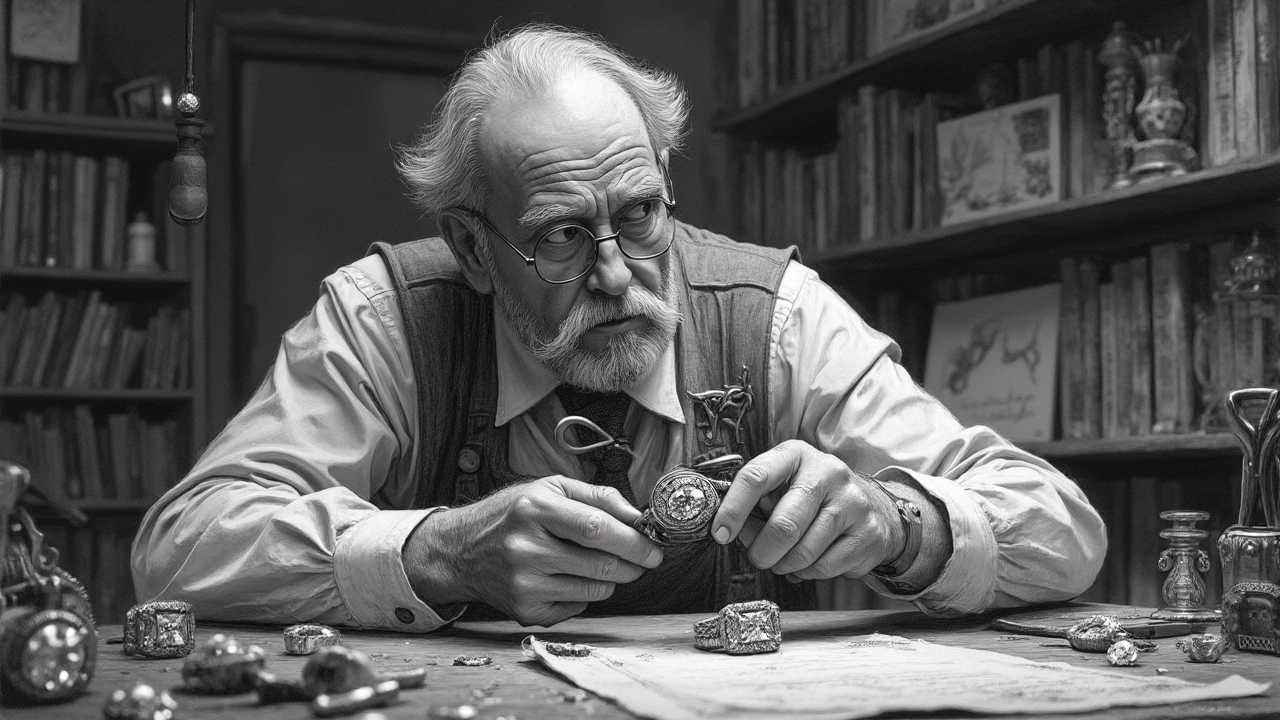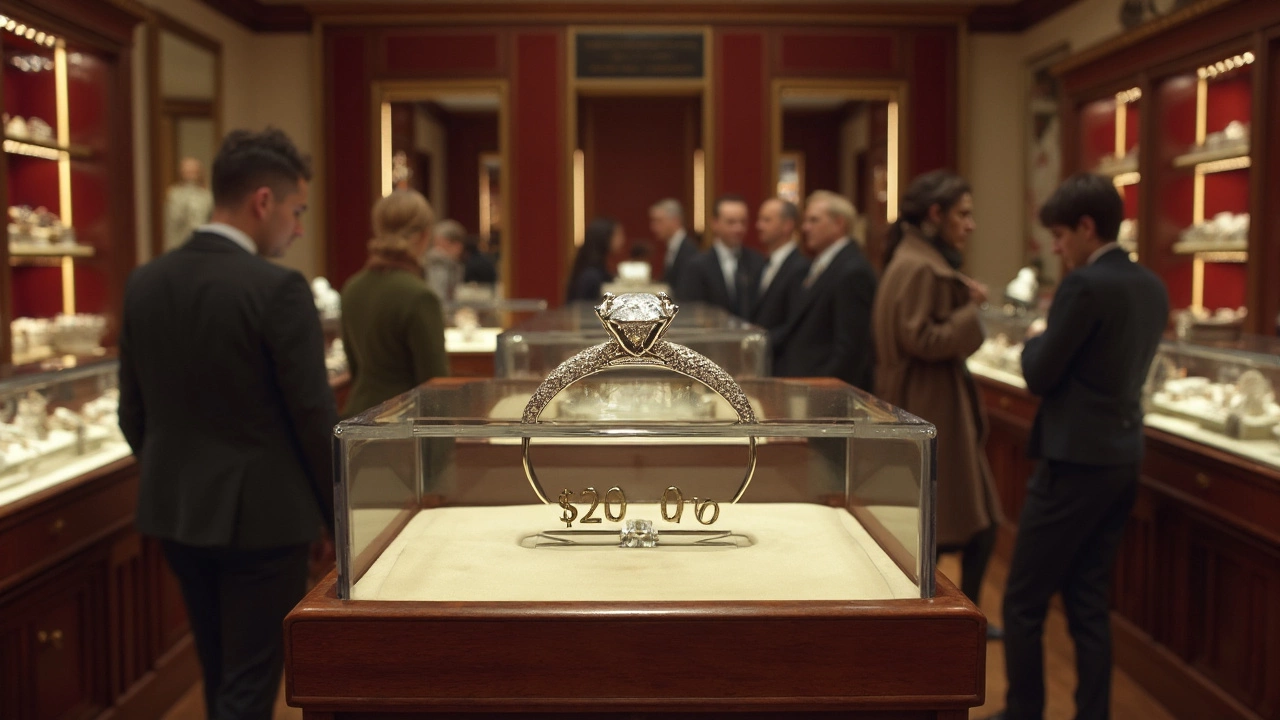Picture this: you've decided to pop the question, and you're staring at a $20,000 price tag on what could be the most significant purchase of your life so far. Is it too much? What are you really paying for? Let's break it down.
First up, there's the value of what you're getting. Diamonds aren't all created equal, and a big chunk of that $20,000 is all about quality. The Four Cs—cut, color, clarity, and carat weight—are your new best friends. A perfectly cut diamond that sparkles more brilliantly than a disco ball can really make a statement. But do you need all that dazzle? That's for you to decide.
Then, of course, there's the social bit. Society often nudges us toward thinking bigger is better. Your friend got a giant rock last year, and now you're feeling the heat. But hey, that's their ride, not yours. What's your story? What works for you and your partner?
- The True Value of a $20,000 Ring
- Understanding Diamond Quality
- Social Expectations vs. Personal Choices
- Financial Responsibility
- Making the Decision
The True Value of a $20,000 Ring
Alright, so you're staring at this diamond ring with a $20,000 price tag and wondering what's behind it. Trust me, it’s not just sparkles and glitz. First off, let's talk diamonds. They're rated by something called the Four Cs, which are cut, color, clarity, and carat weight. These four traits decide the quality and, ultimately, the price.
The engagement ring market sets baseline prices based on these qualities, among other things. A larger carat size is eye-catching, sure, but a well-cut diamond reflects light better, giving it that extra shine. The color and clarity further ensure that you’re not just seeing a glimmer but a genuine shimmering masterpiece.
Now, some hard facts: only about 1% of diamonds are considered flawless, pushing prices up. Another quick peek into social trends shows that around 10% of people put down $20,000 or more for their wedding rings. Is it a club you definitely want to join? Your call.
- History and Tradition: Diamonds have symbolized power and love for centuries. An intricate tradition surrounds them, adding to their allure.
- Investment Value: Unlike that trendy gadget, a well-chosen diamond can be a stable investment, maintaining value over the years.
- Personal Significance: The ring represents a major life commitment, so it carries more weight than just carats.
In the end, determining if $20,000 is well spent comes down to more than just the price tag. It's about quality, personal meaning, and perhaps a bit of financial savvy. Whatever you decide, make sure it feels right for you and the love story you're about to embark on.
Understanding Diamond Quality
Let's dive into the world of diamonds and figure out what makes a diamond worth $20,000. The Four Cs—cut, color, clarity, and carat weight—are the key players here. Knowing your Four Cs can save you from overpaying and help you choose a wedding ring that's genuinely valuable.
Cut is all about the angles and proportions. A well-cut diamond reflects light beautifully, making it sparkle like nothing else. It's not just about the shape, but how precisely it's been cut to maximize its brilliance. A $20,000 price tag often indicates a premium cut, which means more sparkle and less light leakage.
Next, there's color. Diamonds are graded from D (colorless) to Z (light yellow or brown). The less color, the higher the value, because colorless diamonds allow more light to pass through, enhancing that fiery sparkle. A high-priced diamond is usually in the D-F range, which can be a true reflection of value if a clear diamond matters to you.
Clarity measures the imperfections or 'inclusions' in a diamond. Fewer inclusions mean a clearer diamond, which equals higher quality and cost. But here's a tip: minor inclusions often go unnoticed to the untrained eye, so sometimes a VVS2 (very, very slightly included) might be a savvy buy over flawless stones.
The carat weight is about how big the diamond is. Naturally, larger diamonds are rarer and pricier. Most of that $20,000 could be tied up in this if you're aiming for size. But remember, a one-carat diamond that's perfectly cut can sometimes look just as impressive as a lower-quality two-carat one.
Looking at these factors helps justify the cost of a high-end diamond. It's not just a rock—every quality speaks volumes about its value. However, if you're open to alternatives, non-traditional cuts or slightly lower in one of the Cs might offer more bang for your buck while still getting you a drop-dead gorgeous engagement ring.

Social Expectations vs. Personal Choices
It's no secret that society often dictates what's considered the 'norm' when it comes to engagement rings. Some folks feel that an engagement ring needs to be a whopping chunk of their annual salary—thanks to a marketing ploy from decades ago! The infamous 'three months' salary' rule was actually just a clever ad campaign by diamond companies to boost sales after the Great Depression.
But trends are changing. More couples are bucking tradition and opting for what feels right for them instead of what Instagram says. For instance, many are choosing gemstones like sapphires or emeralds instead of traditional diamonds, not just to save money, but to showcase personality.
Here's a juicy stat for you: Millennials and Gen Z are shelling out less on average for engagement rings compared to older generations. A 2024 survey showed that around 70% of these younger buyers prioritize the value and meaning over the price tag or size. A smaller, more personal, ring that tells their unique story is often more cherished than a big, flashy rock.
Plus, there's always the environmental factor. More people are becoming aware of the ethics behind diamond mining and are opting for ethically sourced or lab-grown diamonds. These alternatives often come at a fraction of the cost and carry fewer environmental concerns. So, even if you're swiping that card for a high-end ring, it's worth knowing where it comes from.
At the end of the day, what matters most is that the ring fits your partner's vibe and your shared values. A little bling never hurts, but the love and memories behind it—no matter the cost—are what truly shine.
Financial Responsibility
Money talk—it's a biggie, right? So you're eyeing that $20,000 engagement ring, but how do you know if it's financially smart or way out of bounds? Let's break down what smart spending looks like when it comes to wedding bling.
First rule of thumb: know your budget. The age-old advice says you should spend about two months' salary on a ring. But guess what? Rules are meant to be broken, especially outdated ones! What's more important is how that spending fits into your overall financial goals. Do you want to travel, buy a house, have a safety net? Factor those goals in.
Wondering how Americans generally fare with ring spending? A recent survey revealed that most people shell out around $5,500 for an engagement ring. So, if you're thinking about going up to $20,000, just make sure it's something your bank account can handle without needing an oxygen mask.
Here's a quick checklist for keeping your finances in check:
- Set a Realistic Budget: What can you spend without breaking the bank?
- Compare Prices: Look around—sometimes a little shopping around can save you big bucks.
- Consider Financing Options: Is it worth paying in installments, or would you rather avoid monthly payments?
- Plan for Additional Costs: Don't forget about insurance and potential future resizes.
At the end of the day, being financially responsible can keep your relationship and wallet happy. Know what's reasonable for you, and don't let shiny objects lead you astray. If you’re unsure about any of this, sit down with your partner or a financial advisor, and make a decision that doesn't make your heart or finances skip a beat.

Making the Decision
So, you've made it this far, and now it's decision time. Do you drop that huge chunk of change on a $20,000 engagement ring? Or do you opt for something a bit more budget-friendly?
First things first, let's talk about what you really want—and be honest with yourself here. Is this ring all about that once-in-a-lifetime moment, or is it more about keeping up with the Joneses? A study from the National Research Group found that nearly 30% of couples regret spending too much on their rings, mainly because they felt pressured by outside expectations.
It's crucial to align your ring choice with your and your partner’s values and long-term goals. Remember, this is a ring you'll (hopefully) wear every day, so it should reflect your style and story, not just a price tag.
“The true value of an engagement ring is how it represents the bond between the couple, rather than its price,” says Dr. Emily Blaine, a well-known relationship expert.
Here's a handy checklist to help weigh your decision:
- Budget-wise: Does this fit into your financial plans without causing sleepless nights?
- Priorities: Is a big wedding more important to you than a big ring?
- Alternative investments: Could part of that $20,000 be better spent on a down payment for a home or a dream honeymoon?
When it comes to big investments like a diamond ring, it's worth considering the return on investment. While the emotional value is immeasurable, keep in mind that diamonds generally don't appreciate in the same way a sturdy real estate purchase might. However, if the ring signifies something deeply meaningful to both of you, that's invaluable.
In the end, make the decision that best suits both your heart and wallet. Remember, the perfect engagement doesn't hinge on a ring's value; it's in the promise of a lifetime together.
